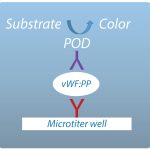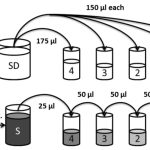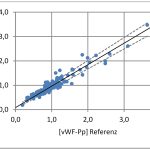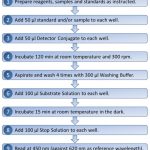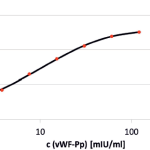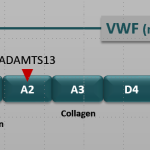von Willebrand Factor Propeptide (vWF:PP) ELISA Test Kit
$0.00
The VWF:PP ELISA test kit is an immunoassay for the quantitative detection of von Willebrand Factor propetide in citrated human plasma. The assay utilizes two monoclonal antibodies against vWF propetide to assess vWFpp activity levels.
Features
- The only commercially available, ready-to-use, complete ELISA kit for determination of vWF:PP
- Precoated microtiter strips (12 x 8 microwell strips, 96 wells)
- Lyophilized calibrators and controls included
- Reagents stable for 4 weeks after opening, or can be stored frozen for a longer timeframe.
- Minimal interference from heterophilic antibodies and RhF
- Rapid (< 90 minutes) and easy assay protocol:
- Results correlate well with existing experimental ELISA using commercially available Ab pair (see Fig. 2)
The content of this kit is sufficient for 96 measurements:
| Microplate strips | 12 strips with 8 wells each, coated, individually shrink-wrapped with desiccant bag |
|---|---|
| Microplate Frame | for holding up to 12 strips for processing the assay |
| Sample Diluent | 2 bottles, 25 ml each, a buffer for pre-dilution of the sample |
| Wash Buffer | 1 bottle 100 ml, 10x conc., for dilution with water |
| Detector Conjugate | 1 bottle, 6 ml |
| Substrate Solution | 1 bottle, 12 ml, for detection |
| Stop Solution | 1 bottle, 15 ml, for terminating the reaction |
| Calibration Plasma | 1 vial, lyophilized for reconstitution with 1 ml water |
| Control Plasma | 1 vial, lyophilized for reconstitution with 1 ml water |
| 1 box insert / instructions for use | |
| 1 sheet with values for calibrator and control |
Required Material not included in the Kit
- Distilled water, or preferably sterile water for injection Calibrated pipettes and pipette tips
- Equipment for blood sampling, if the venipuncture is made directly by the operator
- Microplate reader with 450 nm and 620 nm as reference wavelengths
- Multichannel pipette and reservoir for wash buffer, or automated washing device
- Blotting paper or other absorptive stock material for wash solutions Plastic tubes for preparation of dilutions or storage of samples
- Stop watch
- Shaking device for incubation
What is the function of von Willebrand Factor? Briefly describe von Willebrand disease.
von Willebrand factor (vWf) is a glue-like adhesive protein that is responsible for the adhesion of platelets to damaged vascular endothelium. It also carries and protects factor VIII. von Willebrand disease is a hereditary bleeding disorder caused by moderate-to-severe factor VIII deficiency and low-levels of factor VIII-related antigen (substances necessary for blood clotting). Additionally, there is insufficient von Willebrand factor which also helps blood clot. The von Willebrand factor helps platelets to stick to the blood vessel wall and to each other, which is necessary for normal blood clotting.
Assay Principle
The wells of the plastic strips included in this kit are coated with a monoclonal antibody directed against vWF:PP. The vWF:PP of the sample is pipetted into a well, followed by a second monoclonal antibody against vWF:PP that is conjugated with an enzyme. vWF:PP binds to the antibody attached to the solid phase and gets immobilized. The second antibody with the conjugated enzyme binds to the immobilized vWF:PP as well. After incubation and washing steps all unbound material is removed and added substrate is cleaved by the bound enzyme of the conjugate and releases a dye in proportion to the bound vWF:PP. After a defined time, the reaction is stopped by adding a stop solution. Measuring the absorbance indicates the concentration of vWF:PP. The assay is calibrated by parallel measurement of the included calibrator and its dilutions via a calibration curve. A quality control is possible by simultaneous analysis of the control plasma, which is included in the kit.
Test Procedure
Preparations
Dilute the plasma samples according to the expected concentrations of vWF:PP exclusively with the sample diluent included in the kit. If a regular concentration is expected, a dilution of 1:80 is recommended. If a concentration below the expected range (<300mIU/ml) is expected, a dilution of 1:20 is appropriate. Dilute control identically to sample. The control represents the regular range of the vWF:PP in plasma. A confidence range for the respective lot is indicated on the vial and in the separate sheet in the kit. The indicated concentration represents the value in the reconstituted control prior to dilution. It is recommended that each lab should determine its own confidence ranges.
Preparation of the standard curve
Prepare 5 small tubes (No. 0-4). Dispense 175μl sample diluent (SD) in tube 4, and 150μl respectively into tube 0-3. Dispense 25μl reconstituted calibrator (S) into tube 4 and mix carefully, but avoid foam formation. Dispense 50μl from tube 4 into tube 3 and mix. Repeat these steps for tube 2 and 1. See schematic graph for illustration.
This procedure provides a dilution series with four (4) different standard concentrations for establishing a calibration curve (tubes 1-4) and a blank value (tube 0). If more calibration points are needed, or for different concentration ranges, you may generate additional dilutions. It is recommended to follow the proposed dilution scheme as long as you do not have own experience. The concentration of vWF:PP as indicated on the vial and the value sheet of the calibrator is found in tube 4. The other tubes contain the respective concentrations obtained by the dilution steps.
Assay
- Calculate the number of wells required and open the respective number of pouches. Each pouch contains one strip with 8 wells. Insert the strip into the provided frame.
- Dispense 50μl respectively of a sample, blank, calibrator and control prepared as described above into separate wells.
- Dispense 50μl of the detector conjugate into each well immediately.
- Incubate the samples on orbital shaker at 300min-1 at room temperature for 120min. Alternatively, incubate for 60 min at +37°C / +98°, also with shaking at 300min-1.
- Remove the liquid by inverting the frame over blotting paper or other absorptive material and tapping.
- Wash the wells 4 times with 300μl wash buffer. Empty each well after each washing step.
- After the last washing step, empty the wells as described in step 5 by tapping on absorptive material.
- Dispense 100μl of substrate into each well.
- Incubate in the dark at room temperature for 15 minutes, (for example with aluminum foil covering).
- Dispense 100μl stop solution into each well.
- Immediately measure the absorbance at 450nm wavelength against a reference wavelength of 620nm. The generated color is stable for about 30 minutes at room temperature. All wells need to be measured during this time.
Assay Characteristics
The following data was obtained on a micro plate reader.
| Detection threshold | 2.5mIU/ml |
|---|---|
| Lowest detectable concentration | 5mIU/ml |
| Measuring range | 2.5 – 120mIU/ml |
Method comparison
162 samples from ostensibly healthy subjects with various subtypes of VWF deficiency were compared with a different ELISA for vWF:PP.
A correlation coefficient of 0.9037 was found. The full line in the diagram represents the regression after Passing and Bablok, the hatched line the minim and maxim values for slope and intercept with the y-axis.
Sample Preparation
The assay requires citrate anti-coagulated blood plasma. Preferably, draw whole blood into a collection device for citrate anti-coagulated blood by venipuncture. Alternatively, nine parts of freshly drawn whole blood are mixed with one part of 0.11mol/l sodium citrate solution. Test the sample within one to two hours after sampling. Latest after eight hours.
For preparation of platelet poor plasma, a validated laboratory method should be employed, for example centrifugation at room temperature for 15 minutes at 2000g. The plasma obtained by this procedure should be used within one to two hours; do not exceed 8 hours. Discard older samples. The plasma samples may be frozen.
The sample is stable at -20°C / -4°F for two months. Thaw in a water bath at +37°C / +98°F.
Preparation of Reagents
Make sure all required reagents are taken from the same kit. Do not mix components of various kits. Bring all reagents to room temperature prior to use.
Calibrator and control are freeze-dried and need to be reconstituted prior to use. Vials are under vacuum; remove the stopper after opening of the screw cap carefully in order to avoid any loss of material. Do not mix up the stoppers of calibrator and control. Add exactly 1ml of distilled water free of preservatives. Close the vial with its screw cap and dissolve the lyophilized material by gentle agitation or with an orbital shaker. Avoid harsh shaking and foam formation. After reconstitution, the solutions should stand for 20 minutes prior to use, with gentle agitation from time to time and especially immediately before use. Additional mixing is not required during usage.
Add the required volume of wash buffer concentrate in a plastic tube of appropriate size and dilute it with 9-fold volume of distilled water. Mix well. For one well 4 x 0.3ml = 1.2ml of diluted wash buffer are required, or for one strip = 8 wells = 9.6ml. All other components are ready to use.
Calibration
Prepare a calibration curve for each test with four dilutions as described above, by plotting the difference of the measured optical density (OD 420-620nm) against the concentration in mIU/ml.
Generate a 4-point logistic fit or different appropriate regression method. An example is shown in the figure.
For measuring the concentration of vWF:PP, multiplication with the sample dilution factor is required. For any new assay, a fresh calibration curve is required.
Intra-assay precision
Three samples prepared from pooled plasma with variable known concentrations of vWF:PP obtained by dilution were measured 8-fold in one run.
CV at 60.6mIU/ml 0.1%
CV at 15.2mIU/ml 3.4%
CV at 3.8mIU/ml 8.1%
Inter-assay-precision
Three samples of known concentration of vWF:PP determined by ELISA were measured on eight different lots of this assay. Different concentrations of vWF:PP were obtained by dilution.
CV at 60.6mIU/ml: 0.6%
CV at 15.2mIU/ml: 3.4%
CV at 3.8mIU/ml: 9.8%
Day-to-day-precision
Three different operators used one identical lot of this assay at four days following one another, respectively, to determine the concentration of Control N.
CV at dilution 1:20: 7.8%
CV at dilution 1:80: 5.5%
Operator-to-Operator Precision
Three different operators tested an identical lot of this assay with the identical sample of Control N simultaneously.
CV at dilution 1:20: 4.9%
CV at dilution 1:80: 2.8%
Specificity and Interferences
This assay was developed for the specific and precise measurement of vWF:PP in plasma. The results did not show any influence by the plasma concentration of vWF. By using a specific reagent, interference by heterophilic antibodies or rheumatoid factors is very unlikely.
Hemolytic samples
It is recommended to discard hemolytic samples; nevertheless weakly hemolytic samples could be tested successfully.
Icteric samples
Samples with a bilirubin concentration up to 80μg/ml may be used for this assay.
Lipemic samples
Samples with a triglyceride concentration up to 3.5mg/ml may be used for this assay.
Storage and Stability
The product should be stored at +2 to +8°C / +35 to +46°F. Under these conditions, it may be used until the expiration date printed on the label. Do not use after this date. Do not freeze any content of the kit.
This product may be shipped without chilling if the temperature during transportation does not rise above +25°C / +77°F. It should be immediately stored at +4°C / +39°F after reception. Store all components of the kit inside the box provided, in order to protect from sun light.
Stability after opening
Use the shrink-wrapped strips immediately after opening. Discard them after use, also if unused wells are left. Store all liquids at +2 to +8°C / +35 to +46°F after opening. They may be used for up to 4 weeks after opening. Calibrator and control may be used for up to 8 hours after opening and may be frozen in aliquots. The reconstituted and frozen calibrators and aliquots are stable for 3 months when stored at -18°C / 0°F or lower.
Standard Curve
See Graph
Background
von Willebrand Factor (vWF) is a large, multimeric protein secreted from endothelial cells and present in both plasma and platelets. At sites of vascular injury, it promotes platelet adhesion and aggregation. In plasma, it acts as a carrier protein for Factor VIII. Deficiencies in either the amount or function of vWF can lead to bleeding diathesis. Functional defects are attributed to increased or decreased platelet binding, decreased Factor VIII binding, decreased collagen binding, decreased self-aggregation (i.e. formation of multimers) and decreased GP1b binding. Insufficiencies in levels of vWF in the plasma are attributed either to decreased production of pro-vWF or faster rates of degradation of vWF in the plasma. Understanding the mechanism of vWF deficiency is important because effective intervention varies depending on the source of the vWF defect.
Assessment of von Willebrand Factor propetide (vWFpp) levels in plasma is one such way to elucidate the source of vWF deficiency in research studies. vWFpp is derived from pro-vWF after cleavage by furin. vWFpp remains associated with vWF in endothelial cells and megakaryocytes resulting in 1 molecule vWF antigen (vWF:Ag) and 1 molecule vWFpp (vWF:PP). Expression of vWFpp is required for appropriate intracellular processing of vWF.
Secretion of vWFpp is also equimolar to vWF:Ag as one non-covalent complex, but once in the plasma, vWF:Ag and vWF:PP dissociate and circulate independently. The normal range for the concentration of vWF:PP in plasma is reported to be ~1μg/ml verses the normal range for the concentration of vWF:Ag, ~10 µg/ml. This discrepancy is due to difference in metabolism and clearance of each, which results in a much shorter plasma half-life for vWFpp than for vWF antigen (2 hours vs 12 hours).
Determination of vWFpp levels can yield additional information about von Willebrand Disease (VWD) classification and research. Quantitation can help to pinpoint the source of vWF defects and provide clues to more effective mechanisms of rectifying the vWF deficiency. If the levels of vWFpp detected in plasma are higher than the levels of vWF:Ag, a deduction can be made that the source of the vWF defect may be in degradation rate verses pro-vWF production. On the flip side, if the amount of vWF:PP detected is similar or less than that of vWF:Ag, the defect may be in pro-vWF production verses vWP degradation.
